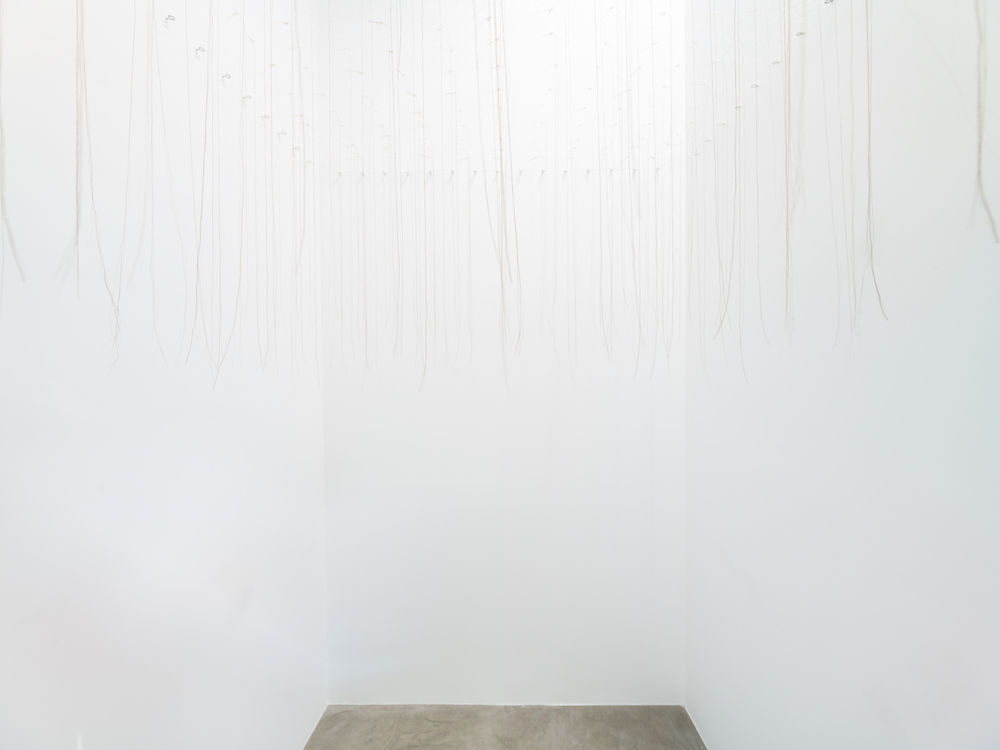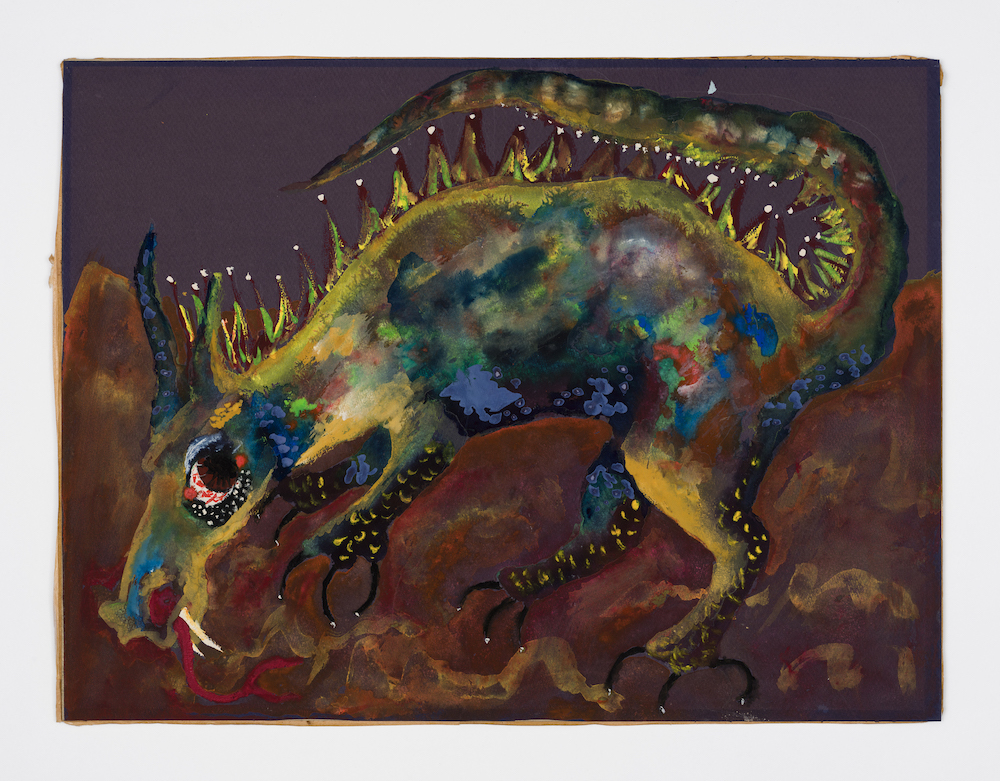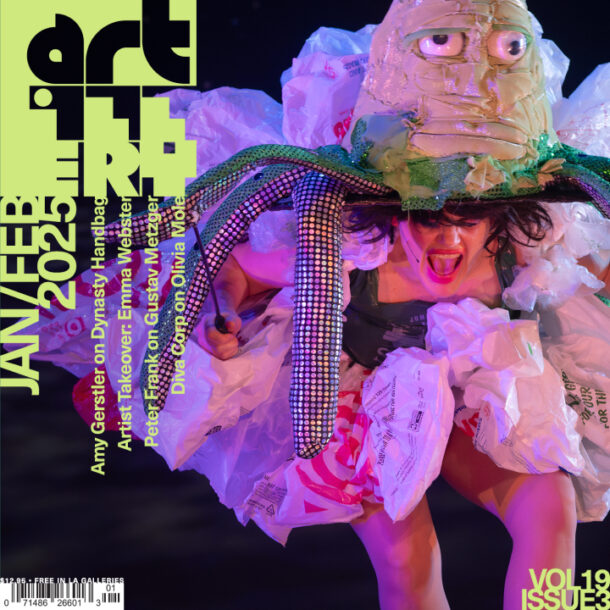Desire can make you sick, or it can make you try. Los Angeles-based artist Nancy Buchanan, working steadily since the 1970s, has consistently chosen the latter. Hair Room (1973/2025), a closet-sized chamber where strings of hair caress the top of your head as you walk through, distills Buchanan’s ethos of seizing what repels—hair, bones, surveillance, environmental and social collapse—and making work from the very point where desire flips into disgust. It’s a fitting entry point for “Truthfully, Nancy Buchanan,” her recently closed retrospective at The Brick, which is less a tidy career survey than it is a triumphant archive of trying.
What you leave with is the sense that Buchanan has tried everything. To call her retrospective an “archive of trying” is not to imply failure but to recognize the depth of her persistence: decades of work carried out through sexism, financial precarity, and social upheaval, often without reward. Throughout her fifty-year career, she moved carnivorously across media, from drawing, performance, video, sculpture, and painting into methodologies so fertile, collaborative, and cross-disciplinary that her practice as a whole resists consolidation into a singular style. In the early 1970s, as many artists moved away from medium-specificity and into the new languages of performance and video, Buchanan’s Los Angeles peers saw their practices resolve into recognizable signatures. Buchanan’s body of work, by contrast, remained diffuse, even fugitive, a reflection of her politics of resisting fixed forms of power, ownership, and spectacle. This fugitivity has contributed to her under-recognition, yet it is also what most strongly connects her to a generation of feminist artists in Southern California, among them Judy Chicago and Barbara T. Smith, who sought to challenge art-world patriarchy and political complacency.
“Truthfully, Nancy Buchanan” traces Buchanan’s formative years in California in the 1970s, when she studied alongside Chris Burden, Alexis Smith, and Barbara T. Smith as one of the early graduate students in UC Irvine’s MFA program. With limited resources and formal studios still developing, the program lent itself to out-of-the-box thinking and using whatever means were available. Out of this atmosphere, Buchanan co-founded F-Space, an experimental gallery where artists could push the possibilities of performance and video—famously, Burden’s Shoot (1971) was staged there. From early on, Buchanan’s practice was never just an individual output, but part of a web of artists inventing their own institutions and surviving together. That collaborative impulse extended beyond the art world, too: she worked closely with LA-based activist and journalist Michael Zinzun, helping produce his cable-access television show “Message to the Grassroots.” The performance and video scene in California was small, tight-knit, and self-organized, emerging when video still felt like a new, democratic medium through which artists could assert control over systems of power and representation.

Nancy Buchanan, Hair Room, 1973/2025. Courtesy of the artist and The Brick.
Critics often frame Buchanan’s career through the lens of political urgency, emphasizing her long engagement with nuclear disarmament, feminism, and social inequality, but what comes across most strongly here is less a checklist of positions than a record of shifting tactics. In six sequined works made between 2001 and 2002, she charts income increases from the lowest 10% to the top 1%, as well as fluctuations in the stock market and gas prices. Fashioned into gaudy pie slices, bar graphs, and jagged data lines, the works glitter with cartoonish excess while the numbers expose disturbing consolidation at the top. In the center room, working with frequent collaborator Carolyn Potter, Buchanan constructs a miniature mansion titled American Dreams #7: The Price is Wrong (1991); inside, lined with portraits of the wealthy, a tiny video on the lack of affordable housing plays like a grandiloquent little trap. The scale, a luxurious mansion reduced to a dollhouse, mocks itself, but the critique is blunt: Wealth is a shell game, a closed circuit of accumulation in which the promise of comfort and status is built upon exclusion. For Buchanan, mediums are not treated like fixed containers but as parallel tracks, each leading back to the same stubborn pursuits: How to live, how to care, how to tell the truth.
Her persistence is perhaps clearest in her long engagement with hair: in the final room, Hair Piece (1972/2012), a rug made from barbershop remnants of human hair and poodle fur styled like a minimalist mandala, lies unflinchingly on the floor. As a graduate student, visiting critics dismissed the work as grotesque, which only solidified her interest in pursuing hair as material. A display case of Buchanan’s juvenilia includes Dragon (1960), a brightly colored painting made at just thirteen, already foreshadowing her fascination with animals, bodies, and whimsicality. Twenty-six years later, in Boys Club (The Critics) (1986), she illustrates a German hunting lodge in neon pastel, replete with Romanesque columns, velvet sofas, and a fireplace, then scrawls the names of art-world patriarchs like Clement, Harold, and Donald on the wall like graffiti. She situates this uncanny interior within a darkly stained, baroque frame, as if to seal the satire. Curators Catherine Taft and Laura Owens’ decision to include such early and late work in the same space historicizes Buchanan’s career on its own terms, offering her the same recognition long extended to the very “boys club” that faintly acknowledged her in real time. Nearby, cHair (2020), a small pink chair drooling with cherry-red strands, perches beside Hairbrain (2020), a clear acrylic brain enclosed around locks of red human hair. Hair is erotic until it’s cut, then it’s revolting, destined for the trash, and what most would sweep away, Buchanan builds into a room.
Humor threads through the show as another strategy for metabolizing desire, which often edges into perversity. Erotic drawings render “hard” sex acts into “soft,” more feminine forms, are awkward yet candy-coatedly sweet, while large photographs of black and grey frosted cakes in 50 Shades of Cake (2014) read almost like images of soft-core porn. In No One’s Ark (2002–present), a series of drawings, paintings, and collages of endangered condors, orangutans, and zebras each appear in a different style, as if every species demanded its own medium. Nearby, a series of pencil and pastel drawings of chewed-up dog toys, which began as an homage to her late friend Mike Kelley, suggest a love so consuming it leads inevitably to destruction. A dedicated room in the exhibition loops selections from Buchanan’s video work; video has always been a vital part of her practice, though here it feels more like a necessary inclusion than the exhibition’s beating heart.

Nancy Buchanan, Dragon, 1960. Courtesy of the artist and The Brick.
The Brick gives Buchanan’s works on paper, long overshadowed by her video and performance, ample space, revealing a constant record of her hand that asserts itself as an important through-line in her career. The exhibition is thorough, historically engaged, and clearly the result of deep research, folding Buchanan back into a broader reconsideration of California art history. The Brick, up for the task, has styled itself like a museum, with vitrines, archival images, and a reading room, yet it still carries the charge of an artist-run environment. That mix of polish and improvisation, the carefully crafted and the casually urgent, mirrors Buchanan’s own practice, which has always thrived in the gap between the two.
On my second visit, I arrived as Buchanan was leading a walkthrough. Listening to her, I wanted to thank her directly—for her example makes clear that desire itself can be a method: one that is more transmissible, enduring, and irresistible than any formal medium, or fixed boundary between them. Hair keeps returning in the show because it insists on its own life. That is why it is used to clean up oil spills: hair binds to what is toxic and draws it out.


